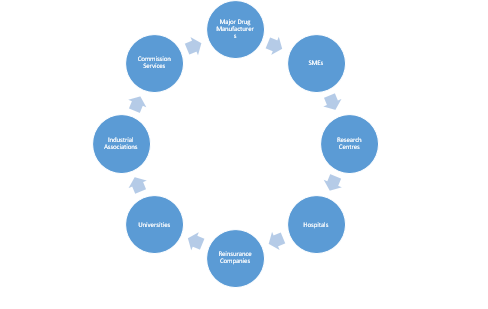
Global Nanomedicine Market – Forecast to 2023
- December, 2016
- Domain: Healthcare - Biotechnology
- Get Free 10% Customization in this Report
Global Nanomedicine Market by Therapeutics (Oncology, Cardiovascular, Neurology, Anti-inflammatory, Anti-infective, and Other Therapeutics) Drivers, Opportunities, Trends, and Forecasts: 2017-2023
Overview:
Nanomedicine is an offshoot of nanotechnology, and refers to highly-specific medical intervention at the molecular scale for curing diseases or repairing damaged tissues. Nanomedicine uses nano-sized tools for the diagnosis, prevention and treatment of disease, and to gain increased understanding of the complex underlying pathophysiology of the disease. It involves three nanotechnology areas of diagnosis, imaging agents, and drug delivery with nanoparticles in the 1–1,000 nm range, biochips, and polymer therapeutics.
Majority of nanomedicines prescribed currently, allow oral drug delivery and its demand is increasing significantly. Although these nanovectors are designed to translocate across the gastrointestinal tract, lung, and blood–brain barrier, the amount of drug transferred to the organ is lower than 1%; therefore improvements are challenging. Nanomedicines are designed to maximize the benefit/risk ratio, and their toxicity must be evaluated not only by sufficiently long term in vitro and in vivo studies, but also pass multiple clinical studies.
Market Analysis:
The “Global Nanomedicine Market” is estimated to witness a CAGR of 17.1% during the forecast period 2017–2023. The nanomedicine market is analyzed based on two segments – therapeutic applications and regions.
The major drivers of the nanomedicine market include its application in various therapeutic areas, increasing R&D studies about nanorobots in this segment, and significant investments in clinical trials by the government as well as private sector. The Oncology segment is the major therapeutic area for nanomedicine application, which comprised more than 35% of the total market share in 2016. A major focus in this segment is expected to drive the growth of the nanomedicine market in the future.
Regional Analysis:
The regions covered in the report are the Americas, Europe, Asia Pacific, and Rest of the World (ROW). The Americas is set to be the leading region for the nanomedicine market growth followed by Europe. The Asia Pacific and ROW are set to be the emerging regions. Japan is set to be the most attractive destination and in Africa, the popularity and the usage of various nano-drugs are expected to increase in the coming years. The major countries covered in this report are the US, Germany, Japan, and Others.
Therapeutic Application Analysis:
Nanomedicines are used as fluorescent markers for diagnostic and screening purposes. Moreover, nanomedicines are introducing new therapeutic opportunities for a large number of agents that cannot be used effectively as conventional oral formulations due to poor bioavailability. The therapeutic areas for nanomedicine application are Oncology, Cardiovascular, Neurology, Anti-inflammatory, Anti-infectives, and various other areas. Globally, the industry players are focusing significantly on R&D to gain approval for various clinical trials for future nano-drugs to be commercially available in the market. The FDA should be relatively prepared for some of the earliest and most basic applications of nanomedicine in areas such as gene therapy and tissue engineering. The more advanced applications of nanomedicine will pose unique challenges in terms of classification and maintenance of scientific expertise.
Key Players:
Merck & Co. Inc., Hoffmann-La Roche Ltd., Gilead Sciences Inc., Novartis AG, Amgen Inc., Pfizer Inc., Eli Lilly and Company, Sanofi, Nanobiotix SA, UCB SA and other predominate & niche players.
Competitive Analysis:
At present, the nanomedicine market is at a nascent stage – but, a lot of new players are entering the market as it holds huge business opportunities. Especially, big players along with the collaboration with other SMBs for clinical trials of nanoparticles and compounds are coming with new commercial targeted drugs in the market and they are expecting a double-digit growth in the upcoming years. Significant investments in R&D in this market are expected to increase and collaborations, merger & acquisition activities are expected to continue.
Benefits:
The report provides complete details about the usage and adoption rate of nanomedicines in various therapeutic verticals and regions. With that, key stakeholders can know about the major trends, drivers, investments, vertical player’s initiatives, government initiatives towards the nanomedicine adoption in the upcoming years along with the details of commercial drugs available in the market. Moreover, the report provides details about the major challenges that are going to impact on the market growth. Additionally, the report gives the complete details about the key business opportunities to key stakeholders to expand their business and capture the revenue in the specific verticals to analyze before investing or expanding the business in this market.
Key Stakeholders:

Request for TOC at sales@infoholicresearch.com
Research Framework
Infoholic research works on a holistic 360° approach in order to deliver high quality, validated and reliable information in our market reports. The Market estimation and forecasting involves following steps:
- Data Collation (Primary & Secondary)
- In-house Estimation (Based on proprietary data bases and Models)
- Market Triangulation
- Forecasting

Market related information is congregated from both primary and secondary sources.
Primary sources
involved participants from all global stakeholders such as Solution providers, service providers, Industry associations, thought leaders etc. across levels such as CXOs, VPs and managers. Plus, our in-house industry experts having decades of industry experience contribute their consulting and advisory services.
Secondary sources
include public sources such as regulatory frameworks, government IT spending, government demographic indicators, industry association statistics, and company publications along with paid sources such as Factiva, OneSource, Bloomberg among others.
